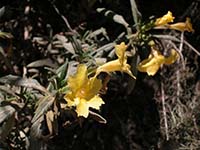Revising a species' classification and name
Taxonomists do revise plant classification (usually based on new information). Then they have to rename some of the plant groups that are affected. In renaming plants...
- The first published name takes precedence (in cases where some group of plants has to give up its name)
- As much of the previous name is preserved as possible
- The author who first described the group remains as part of the name in parentheses. (The author who is renaming the group becomes the new author, whose name is outside the parentheses.

Example: Diplacus aurantiacus (Curtis) Jeps. is the scientific name for orange bush monkey flower (a.k.a sticky monkey). Interpreting this name, you see that Curtis (William Curtis, 1746-1799) originally described the species. (He had named the species Mimulus aurantiacus, but you can't tell that by looking at the name.) You can see that Jepson (Willis Linn Jepson, 1867-1946) came along later, revised the classification of this species and renamed it.
Another example:
In 1842, John Claudius Loudon described Lodgepole pine and named it Pinus contorta. The official name was Pinus contorta Loudon.
In 1868, Filippo Parlatore described Bolander pine and named it Pinus bolanderi. The official name was Pinus bolanderi Parl.
In 1957, Willian Burke Critchfield examined these (and other) pine species and concluded that these two belonged in the same species and should be considered subspecies.
- Pinus contorta became Pinus contorta Loudon ssp. contorta...(No real change in author. The species took the name Pinus contorta, rather than Pinus bolanderi because P. contorta was the first name published)
- Pinus bolanderi became Pinus contorta Loudon ssp. bolanderi (Parl.) Critchf. ...("bolanderi" remained part of the name, to retain as much of the name as possible. However, it was demoted to the subspecific epithet. Parlatore's name got to stay in the name, because he first described the group. Critchfield puts his name as the author, because he reclassified the species and gave it a new name.
Note that if someone comes along after Critchfield and reclassifies Bolander Pine again, Critchfield's name just gets dropped. The only two groups of authors in a revised name are (1) the author(s) that initially described the group, and (2) the author(s) that have published the current revision and the current name.